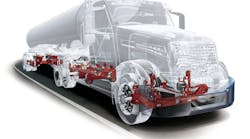Roadways are imperfect; they can be uneven, bumpy and rough. So, in order to provide comfort to drivers and prevent damage to cargo and the vehicle itself, manufacturers design vehicles with suspensions.
Suspensions follow a basic principle: isolate the body of the vehicle from the wheels to provide a smoother ride. Modern suspensions use some form of spring in order to achieve this. Springs can flex, allowing the wheels to move up and down over uneven surfaces independently from the body, leaving the body to travel relatively smoothly.
The stiffness of a spring and how much it can flex is known as the spring rate.
“The spring rate is fundamental to how soft or how hard a suspension rides or feels to the driver,” says Jason Heath, Neway truck suspension and lift axle product manager at SAF-Holland. “It is also fundamental to how a vehicle handles.”
SAF-Holland manufactures axle and suspension systems, fifth wheels, kingpins and landing gear for the commercial market.
While a lower spring rate provides a more comfortable ride, it is not ideal for vehicle handling and stability, Heath says. This is especially an issue for commercial vehicles hauling heavy loads, since the weight of the load will push the springs down even further. To correct this, engineers specify a higher spring rate to give the vehicle better handling, stability and capacity.
With traditional leaf springs, however, a higher spring rate equates to a suspension that is quite firm and creates a rough ride for the driver, the cargo and the vehicle itself. This is particularly apparent when the vehicle is not loaded.
Why air suspensions?
Air suspension can provide the best of both worlds. Air suspensions use air springs - rubber bellows filled with pressurized air - instead of traditional coil or leaf springs, and the air pressure in the suspension can be increased or decreased depending on load.
“Air ride suspensions require a special air valve called a height control valve that controls the amount of air pressure in the air spring,” Heath says. “When the vehicle is loaded with more cargo, this valve senses movement between the axle and chassis. In this case, the axle will ‘squat.’ When this movement is substantial, the valve will send more air pressure to the air springs to bring the axle back to the appropriate height. Suspension engineers call this ride height.”
The same is also true when unloading the vehicle, Heath confirms. In this case, the axle will lift the chassis and the valve will sense this movement and will exhaust air from the air springs to bring the axle back to ride height.
This results in better handling and stability and a smoother ride, whether or not the truck is loaded.
“Air suspensions provide improved cargo protection, which can help reduce claims for damaged freight,” says Steve Hampson, director of marketing and business development at Hendrickson International. “This can also expand the types of cargo that can be transported.” He notes that a smoother ride also protects components such as lights and hinges, leading to reduced maintenance costs.
Hendrickson is a manufacturer of medium and heavy duty mechanical, elastomeric and air suspensions, as well as other components, for the commercial transportation industry.
Another benefit to air suspensions is that they keep the vehicle level and at the same height whether loaded or unloaded.
“Keeping the vehicle level also reduces wear on a vehicle’s tires,” says Graham Brookes, director of technology at air spring manufacturer Firestone Industrial Products. If the vehicle is not riding level, there is a risk of tires wearing unevenly, and therefore requiring replacement more quickly.
Parts and components
Suspensions of any kind are relatively complex systems, and air suspensions add a layer to that complexity. The major components of an air suspension are the air spring, the height control valve and the shock absorber. These components work together to provide a smooth, level ride.
Air spring
“An air spring is comprised of three main elements,” says Firestone’s Brookes. “The bead plate is at the top of the equipment and attaches to the vehicle frame, crimping the bellow. The bellow, which is typically made from durable rubber or heat-resistant neoprene, provides suspension by applying air pressure at an equal force to the load it is carrying. Finally, the piston at the bottom attaches to the suspension and is shaped to provide a particular ride characteristic based on the vehicle manufacturer requirements.”
Brookes indicates that the air spring rolls up and down the piston, following its contour as the suspension goes through its motion, reacting to the road surface and impacts such as potholes and uneven paving.
He also notes that air supply for the air springs typically comes from the same system that supplies air to the air brakes.
Height control valve
The height control valve adjusts the air pressure inside the air springs to maintain a constant ride height. When the height is determined to be dropping, such as during loading, the valve adds air pressure to the air springs in order to bring the vehicle back to level. When the height is determined to be rising, such as during unloading or when unhooking a trailer, the valve will release pressure from the air springs to lower the vehicle to its correct height.
Shock absorber
Shock absorbers work basically the same in an air suspension as they do in a traditional spring suspension. Their purpose is to dampen the effects of the springs, limiting suspension movement to create a controlled motion. Without shock absorbers, the vehicle would simply bounce on its springs in an uncontrolled manner, leading to very poor handling and stability.
Shock absorbers sometimes serve a dual purpose in air suspensions, however. If the vehicle “bottoms out” or reaches the limit of suspension travel, the shock absorber can act as a bumper stop to prevent the suspension from traveling beyond that limit and damaging the air springs.
“Shock absorbers for air suspensions would be more likely to include a hydraulic rebound stop feature, as they typically also function as the suspension travel limit,” says Gerald Anderson, engineering manager at Gabriel HD. Gabriel is an aftermarket and OE manufacturer of shocks and struts for light and heavy duty trucks.
Potential issues
Like most moving parts of a vehicle, suspension components can eventually break down.
“Air springs are a consumable item as they do wear over time,” says David Brinkman, category director of suspension products at Stemco. “Possible issues can be over- or underinflation and damage from road debris. Another issue is worn or damaged shock absorbers, which will allow the suspension to travel beyond design limits.”
Stemco is a manufacturer of commercial vehicle wheel end, braking and suspension components, as well as tire and mileage solutions.
A ride height that is outside of the manufacturer’s specification can also cause problems with air suspensions. Drivers should pay attention to how the truck rides and handles, as any change could indicate a potential issue.
“Poor ride quality could be an indicator that there is an issue that needs to be addressed,” says Hendrickson’s Hampson. “For instance, it could indicate that the suspension ride height is set incorrectly, or that there is excessive component wear or damage.”
Maintenance
Fortunately, many major issues with air suspensions can be avoided with proper preventative maintenance (PM) practices. Regular inspections of critical components should be performed to keep air suspensions in working order and to maximize the life of these systems.
“Take advantage of the information and training provided by your suspension supplier to ensure that your suspension operates at peak performance over the vehicle’s lifetime,” Hendrickson's Hampson says.
Air springs and hoses
“Air springs should be inspected periodically for leaks, damage to the reinforced rubber bellow or material build-up on the outside of the air spring,” Stemco’s Brinkman says.
Spraying air springs and air hoses with soapy water while the system is at operating pressure is a good way to check for leaks, SAF-Holland’s Heath confirms. If leaks are found, connections should be re-tightened and parts replaced as necessary. He adds that all rubber parts should be visually inspected for cracks and wear, and suspect parts should be replaced.
In addition to inspection, air springs should be cleaned regularly to avoid buildup of road residue.
“Air springs should be washed with approved cleaning materials, including soap and water, methyl alcohol, ethyl alcohol and isopropyl alcohol, to prevent build-up and imbalance,” says Firestone’s Brookes.
Ride height
Manufacturers specify a ride height for each vehicle to provide optimal performance and longevity. It is possible for this height to move outside of specification, which can cause issues. Ride height should be checked on a regular basis to avoid complications and potential damage or excessive wear to components.
“Proper vehicle height should be maintained,” says Brookes. “Individual proper vehicle heights can be found in the OEM service manual. Height control valves play a large part in ensuring the total air spring system works as required, and should be regularly examined and replaced if necessary.”
While ride height can be adjusted using the height control valve, manufacturers advise that it is rarely necessary, and some do not recommend that fleets make this adjustment themselves.
“The ride height is carefully designed by both the suspension supplier and the vehicle OEM,” SAF-Holland’s Heath says. “Whenever you wish to make ride height adjustments, we advise you work directly with your dealer. The reason for this is damage can occur when the vehicle operates outside of its intended ride height.”
To learn more about checking ride height, see the sidebar, “Air suspension ride height measurement procedures.”
Shock absorbers
The health of an air suspension largely depends on the health of the shock absorbers. If a shock absorber is worn or damaged, it can quickly cause damage to air springs and other components, so shock absorber performance should be tested regularly.
“An easy way [to check shock absorber performance] is to take the vehicle for a 15-minute drive,” says SAF-Holland’s Heath. “Then park the vehicle and check to see if the shock is hot. Be careful not to burn your hand. If it is hot, it is working and does not need to be replaced. If it is cold, it means the shock is not damping any movement and needs replacement.”
Future trends in air suspensions
Like many vehicle systems, suspension technology is advancing. And, as with other systems, the main goals are increased efficiency and reduced maintenance.
“Emerging technology such as electronic height/ride control systems are a trend for the future which would allow for adjustable ride height,” Stemco’s Brinkman says. “This would help, for example, to lower ride height to improve fuel economy.”
Already, manufacturers are working on incorporating ‘smart parts’ into vehicles. Firestone Industrial Products, for example, has developed an electronic sensor that can measure ride height much more accurately than the typical valve setup.
“In combination with the height control system, it lowers the need for air significantly, and that in turn aids fuel efficiency,” Firestone’s Brookes says. “More than just controlling ride height, the sensor can also provide pressure for load calculations and alert of issues with off-balance tires that will otherwise continue to wear out quickly.”
Further in the future, autonomous vehicles will require even more built-in intelligence.
“For future mobility demands, such as autonomy, the air spring will need to be aware of its condition and respond by self-diagnosis,” Brookes continues. “Known as ‘edge analytics,’ the possibility of detecting potential downtime before it happens allows for preemptive maintenance to maximize uptime in an increasingly busy world.”
Conclusion
Regardless of what the future brings, current air suspension technology can be a worthwhile investment for fleets, with improved handling, performance and ride for both driver and cargo. But, it is important to keep in mind that a proper PM and inspection schedule is imperative to keeping air suspensions operational and extending their longevity.




